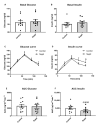Acute Consumption of Blueberries and Short-Term Blueberry Supplementation Improve Glucose Management and Insulin Levels in Sedentary Subjects
- PMID: 33922965
- PMCID: PMC8147004
- DOI: 10.3390/nu13051458
Acute Consumption of Blueberries and Short-Term Blueberry Supplementation Improve Glucose Management and Insulin Levels in Sedentary Subjects
Abstract
Background: Blueberries are polyphenol-rich fruits with antioxidant and anti-inflammatory properties. Polyphenols from berries act by blocking digestive enzymes, reshaping gastrointestinal microbiota, and affecting the release of gastrointestinal hormones to regulate insulin dynamics and glucose management. However, most studies use fruit extracts instead of fresh fruit. We aimed to evaluate postprandial glucose management and antioxidant capacity of fresh blueberries consumed acutely or as a six-day supplementation in 10 sedentary subjects.
Methods: To evaluate the effect of acute blueberry intake, 150 g of blueberries were consumed together with 150 g of white bread by the subject and blood samples were collected at 0, 30, 60, 90 and 120 min to measure glucose, insulin, and plasma antioxidant capacity. To evaluate supplementation, 150 g of blueberries were provided daily for six days and sample collection was performed at day 7.
Results: Acute consumption of blueberries decreased postprandial glucose area under the curve (AUC) and increased insulin levels at 15 min timepoint. Supplementation did not affect glucose levels but decreased insulin levels at 120 min. No changes in antioxidant capacity were observed.
Conclusions: Consumption of fresh blueberries improves postprandial glucose management presumably due to actions on the gastrointestinal tract, while supplementation improves insulin sensitivity, probably due antioxidant and anti-inflammatory effects.
Keywords: antioxidant; blueberries; glucose management; insulin; polyphenols; sedentary subjects.
Conflict of interest statement
The authors declare no conflict of interest.
Figures




References
MeSH terms
Substances
Grants and funding
LinkOut - more resources
Full Text Sources
Medical

